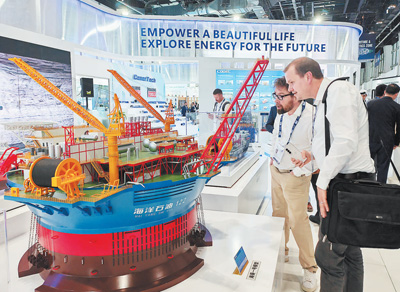The 2024 Abu Dhabi International Petroleum Exhibition and Conference (ADIPEC) recently took place at the Abu Dhabi National Exhibition Centre in the United Arab Emirates (UAE), attracting over 2,200 exhibitors from more than 160 countries and regions.
As one of the world’s largest oil and gas exhibitions, this year’s event focused on artificial intelligence (AI) and sustainable energy transition. More than 300 Chinese companies participated, presenting their latest achievements in digitalization, decarbonization, and renewable energy technologies.

The 2024 Abu Dhabi International Petroleum Exhibition and Conference (ADIPEC) takes place at the Abu Dhabi National Exhibition Centre in the United Arab Emirates (UAE), attracting over 2,200 exhibitors from more than 160 countries and regions. [Photo/sasac.gov.cn]
Spotlight on AI and Decarbonization
The exhibition featured 16 halls, 30 national pavilions and over 370 sessions, covering topics such as hydrogen energy, offshore oil and gas, and financial investment. A dedicated AI zone was established, gathering technology giants like Microsoft to showcase sustainable energy solutions.
Sultan Al Jaber, UAE’s minister for industry and advanced technology and group CEO of Abu Dhabi National Oil Company, emphasized AI’s transformative power. He noted that AI boosts productivity and accelerates energy transition, bridging the gap between reducing carbon emissions and driving socio-economic development.
Suhail Mohamed Al Mazrouei, UAE’s minister for energy and infrastructure, affirmed the country’s commitment to increasing clean energy’s share in its energy mix from 25 percent to 50 percent by 2050, reducing the carbon footprint of power generation by 70 percent, and enhancing energy efficiency by 40 percent. The UAE also aims to strengthen energy security, promote economic stability and meet global energy demand through a low-carbon supply chain and accelerated economic diversification.
Christopher Hudson, president of DMG Events, the organizer of ADIPEC, highlighted the significant funding gap between the Global South and North in the energy transition. He urged developed economies to provide greater financial support for large-scale clean energy projects in emerging markets to prevent delays in the energy transition and increased regional inequality.
Chinese Innovations Draw Attention
At the exhibition, over 100 Chinese enterprises showcased their innovative technologies and solutions across the oil and gas value chain. China National Offshore Oil Corporation (CNOOC) attracted attention with a model of its “Deep Sea No. 1” platform, the world’s first 100,000-ton deepwater semi-submersible production and storage platform. This platform features multiple groundbreaking technologies, including semi-submersible hull oil storage and the world’s largest span truss deck for semi-submersible platforms. Its construction marks a significant leap in China’s deepwater oil and gas development capabilities.
China Oilfield Services Limited, CNOOC Energy Technology & Services Limited, and Offshore Oil Engineering Co., Ltd. jointly exhibited innovative solutions such as the Xuanji and Haikui No. 1.
China Petrochemical Corporation (Sinopec) exhibited a model of a Carbon Capture, Utilization, and Storage (CCUS) project. The project captures and liquefies carbon dioxide emissions from Qilu Petrochemical’s coal gasification process and transports it to Shengli Oilfield for enhanced oil recovery and sequestration, reducing carbon emissions by one million tons annually — equivalent to planting nearly nine million trees.
China National Petroleum Corporation (CNPC) showcased its advanced 10,000-meter drilling technology, highlighting breakthroughs in ultra-deep exploration.
China Zhenhua Oil Co., Ltd. showcased its infrared gas monitoring and intelligent early warning system deployed at Abu Dhabi onshore oilfields, as well as a “digital twin 3D visualization platform” implemented in Iraq’s East Baghdad Oilfield. The infrared system marks the first use of China’s long-distance infrared monitoring technology in high-end international oilfields.
Strengthening Sino-Arab Energy Cooperation
At the 10th Ministerial Conference of the China-Arab States Cooperation Forum, China expressed its commitment to deepening multi-dimensional energy cooperation with Arab states. The participating Chinese companies actively contributed to Sino-Arab cooperation in oil and gas, joint development of new energy technologies, and equipment manufacturing.
China State Shipbuilding Corporation Limited’s Jiangnan Shipyard signed contracts with Arab partners for two 93,000-cubic-meter ultra-large liquid ammonia carriers, the largest of their kind globally. These vessels, designed for green ammonia transport, can also carry liquefied petroleum gases such as propane and butane.
During ADIPEC, BGP Inc., a subsidiary of CNPC, signed a $490 million (3.55 billion yuan) contract with ADNOC for high-density onshore oilfield exploration. The project will leverage advanced intelligent equipment to conduct exploration in ADNOC’s onshore fields. In addition, Jiangsu Guofu Hydrogen Energy Equipment Co., Ltd., partnered with the Khalifa Economic Zones Abu Dhabi Group to establish a hydrogen equipment manufacturing facility in Abu Dhabi, producing equipment for hydrogen generation, storage, and transportation.
Industry leaders praised the growing collaboration between China and Middle Eastern nations, emphasizing mutual efforts to ensure energy security and accelerate the transition toward a sustainable energy future.
(Executive editor: Zhu Zeya)